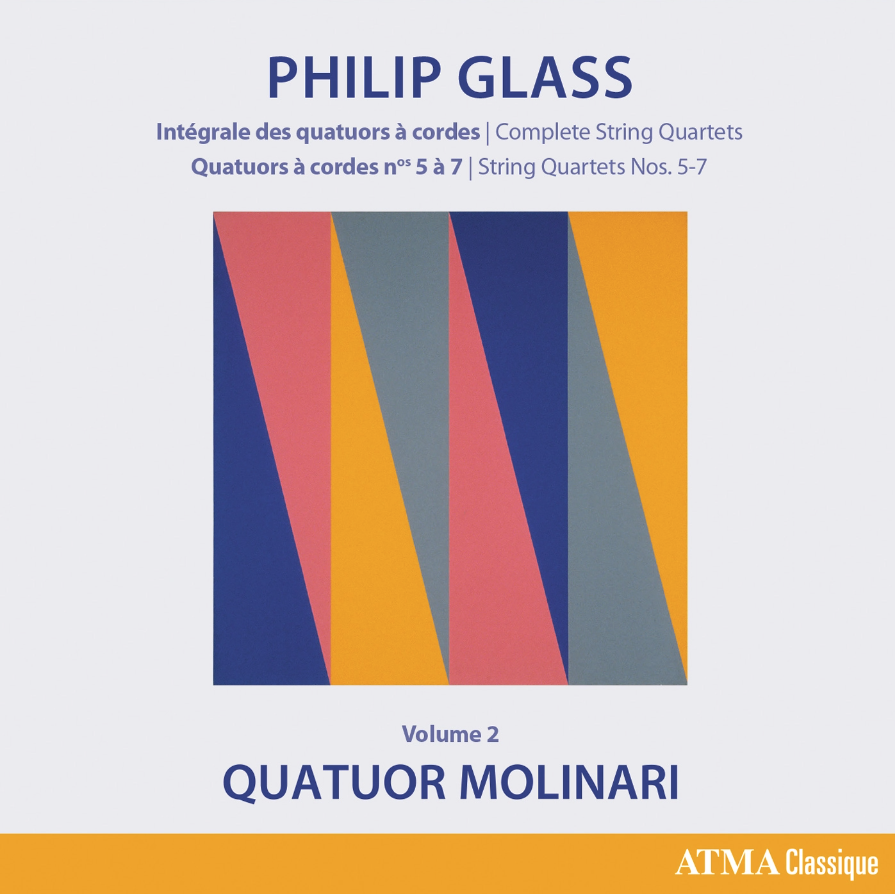Quatuor Molinari releases the second volume of Philip Glass’ “Complete String Quartets”.
A year and a half ago we commented on this website about the release of the first volume of Philip Glass‘ String Quartets by the Molinari Quartet, which included numbers 1, 2, 3 and 4, and a second recording was announced, which would include his quartets 5, 6, 7 and 8. Well… today the new recording has just been released in digital format, but it does not include String Quartet No. 8 and String Quartet No. 9 “King Lear”, but the Canadian label ATMA Classique has already announced on its website that a third volume will be recorded next year and the complete quartets will eventually be released as a boxed set of CDs.
Glass’s String Quartet No. 5 dates from 1991 and was commissioned by the American molecular scientist couple David and Evelyne Lennette for the Kronos Quartet. At the time of its premiere it was considered the most traditional of Glass’s compositions, employing formal structures and expressive contrasts and a sense of organic growth that go far beyond minimalism, while retaining Glass’s unmistakable personal style. The composer himself explained that before composing the work he thought that ” I was thinking that I had really gone beyond the need to write a serious string quartet and that I could write a quartet that is about musicality, which in a certain way is the most serious subject”. His music is insistent and at the same time, depending on the moment, light and dark: a highly successful exercise in contrasts, which is still considered by experts to be the greatest of Glass’s compositions.
It took twelve years to compose his next quartet, No. 6. And it was also the Kronos Quartet that premiered it, in October 2013 at the Chan Shun Concert Hall in the Canadian city of Vancouver. At the time, Glass said that “In contemporary music, No. 6 quartets have taken on special significance, much as symphonies No. 5 and No. 9 have in the history of symphonic music. The number six when applied to a quartet will usually get a composer’s attention. However, in my case I avoided the issue twice.
With the commission from Kronos for a new string quartet, I finally had to address the No. 6 issue. At about a half hour of music, it is a work of significant length. The musical language itself remains firmly ‘post-minimalist,’ as almost everything has been since 1976. It also remains firmly ‘tonal,’ using pan-harmonic and polyharmonic sequences in a rhythmic setting which is, in turn, based on a binary system of twos and threes. This allows for a unified harmonic/rhythmic music in which the resulting melodic material, though basically ambivalent, can be easily heard as harmonic and enharmonic pitches. All this is cast into a three-movement work in which the parts, though structurally separate, flow into each other, much as the movements of my String Quartet No. 5. The string writing itself has taken on a denser, thicker texture, at times sounding like quintet or sextet music. This has come about through the extensive string writing I’ve done – including two violin concertos, two cello concertos, a string symphony (No. 3), as well as numerous solo and ensemble works for string instruments – and has left me familiar and comfortable with all manner of bowing and performance techniques known and practiced by the best players. Understanding and cultivating an aptitude for string writing is a deep and, apparently, endless undertaking.”
Arranged this time in three movements, rather than five, as the previous one, the String Quartet No. 6 is inspired by Spuren der Verirrten (The Lost), the multimedia opera he composed for the Linz Opera just a few months earlier. Texturally dense, full of abrupt contrasts and tense harmonies, the first movement unfolds in a series of dissonant chords reminiscent of the Es muß sein moment at the end of Beethoven’s String Quartet No. 16 in F major, op 135. But the quartet as a whole is more reminiscent of Schönberg, mixing tonal moments with dissonance.
Only a year later Glass composed his String Quartet No. 7, premiered, once again, by Kronos Quartet in July 2014, at the Colours International Dance Festival in Amsterdam as music for the ballet Spiritwalking of the Nederlands Dans Theater, choreographed by the Spanish Sol León – National Dance Prize in 2021 in the Creation category and winner in 2005 of the prestigious Benois de la Danse, for her piece Signing Off – and the British Paul Lightfoot.
String Quartet No. 7 is, in many respects, the most interesting of the three compositions. Unlike Glass’s other quartets, the seventh is developed in a single movement of almost eighteen minutes, exploring both the simple/complex and the more introverted/extroverted elements of the composer’s musical character. It is a work that demands to be listened to with close attention.
